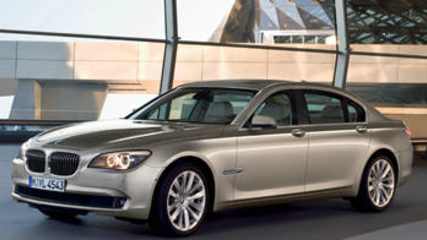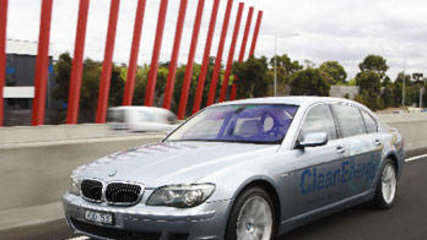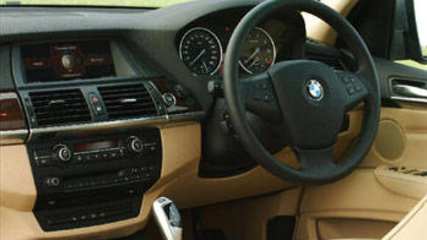BMW 750L News

First drive 2009 BMW 7 series
Read the article
By Paul Gover · 07 Oct 2008
The hulking 7 Series flagship, which set the tone and direction for a whole new generation of edgy BMW bodies from 2001, has been replaced by an all-new car which is more caring, engaging and politically correct.The fifth-generation Seven still has unquestioned impact, from the way it stands on the road to the way it cuts through curves, but is much more friendly and welcoming. Predictably, it makes more power and torque in every case while using less fuel and producing less CO2.It is a step back to the days before the Chris Bangle-driven heavyweight Seven, returning the BMW headliner to the top of a range of driver's cars.The newcome will hit Australia next March, priced from a little under $200,000, and comes with the promise of more performance and luxury, as well as all the technology the German maker can load.That means everything from four-wheel steering to infra-red night vision, lane-departure and blind-spot warnings, and even a camera which recognises speed signs and reminds the driver of the limit.No-one knows yet what will be standard for Australia, but there will be two engines at first - an inline six with 240 kiloWatts for the 740 and a twin-turbo V8 for the 750 with 300 kiloWatts - with both short and long-wheelbase bodies. A diesel will follow before the end of 2009 and could easily become the showroom favourite.The design of the new Seven is softer and smoother, both inside and out, but it is the focus on people's needs which will ignite a tight fight with the Mercedes S-Class for top-end bragging rights. There is plenty of surprise and delight stuff.But the approach is really just a return to the basics which worked so well through the first four generations of the Seven, from a roomy luxury cabin to a dashboard focussed on the driver, a huge boot, lots of toys, and leather-and-wood luxury.The Seven is new from the road upwards and that means everything from a new chassis and body - with a weight saving bonnet-doors-boot combo in aluminium - to a new diesel inline six with 180kW and 540Nm, double-wishbone front suspension, and a vastly improved version of the hated iDrive system.A first drive in Germany, over a wide range of roads near the city of Dresden in the former East of the country, proved the Seven is back to its best. It is refined and comfortable, and a car which is keen to go and gives plenty of feedback and enjoyment to the driver.

Keeping you up to speed
Read the article
By CarsGuide team · 11 Aug 2008
Their car will do it for them, keeping an electronic eye on the road and giving a constant update on the legal limit.The job is done by a new computerised control system — linking a forward-facing camera to sophisticated software that recognises traditional and electronic speed signs — that flashes the current limit to the dashboard and heads-up display.It is fitted first to the new 7 but is expected to move quickly to other models in the BMW family.Unlike satnav-based systems, the BMW design is not pre-programmed and can react to variable-limit signs and time-sensitive limits such as those in school zones. BMW has no plans to link it to a speed limiter.

BMW acts to narrow options
Read the article
By Paul Gover · 14 May 2008
The explosive growth of the BMW model range is about to be defused in Australia, with the line-up being trimmed to cut competition and duplication, making it easier for customers in showrooms.The plan is to have only three choices of any individual model, with two petrol engines and one diesel.The current list includes 36 individual models in the 3 Series sedan line-up ... without counting the coupe, convertible or station wagon.“We get a lot of questions about whetherwe have too many models,” BMW Australia managing director Guenther Seemann says.“I think we do have too many.”He believes BMW must cut the choices to streamline business, though he says there will still be all-new models in future — with the X6 four-wheel-drive and M3 sedan up next — asthe German company looks for customers.The work has begun, though there are a dozen individual BMW lines, from the baby 1 Series to the four-wheel-drive X5 and flagship 7 Series, with 50 official engine choices. BMW has 189 individual models on the list.“We've already begun tidying up. The 116i hatch has been removed from the range, there are the manuals in the 3 Series and one of the X3 manuals,” Seemann says.“In the 5 Series range, one of the V8s will go.I believe for each and every model line-up in the future, as we add models, we need two petrol and one diesel variant in each case. No more. We have so many different model lines, it is not practical or possible to display them all in a showroom.”He says it will take time to get things sorted, partly because there are so many models.“It will happen in the next two years. Globally, there are five petrol and five diesel engine choices. And that is just in the 3 Series range,” Seemann says. But there is definitely space for some additions, like the four-door M3 sedan.“We will bring the four-door version, but I do not know at what price. We have to price it lower than the M3 two-door.”

BMW line-up sliced
Read the article
By Paul Gover · 09 May 2008
The explosive growth of the BMW model range is about to be defused in Australia. The line-up is being trimmed to cut competition and duplication, making it easier for customers in showrooms.The plan is to have only three choices of any individual model, with two petrol engines and one diesel. The current list includes 36 individual models in the 3 Series sedan line-up . . . without counting the coupe, convertible or station wagon.“We get a lot of questions about whether we have too many models. I think we do have too many,” BMW Australia managing director Guenther Seemann says.He believes BMW must cut the choices to streamline business, though he says there will still be all-new models in future — with the X6 four-wheel drive and M3 sedan up next — as the German company looks for customers.The work has begun, though there are a dozen individual BMW lines, from the baby 1 Series to the four-wheel-drive X5 and flagship 7-Series, with 50 official engine choices. BMW has 189 individual models on the list.“We've already begun tidying up. The 116i hatch has been removed from the range, there are the manuals in the 3 Series and one of the X3 manuals,” Seeman says.“In the 5 Series range, one of the V8s will go. I believe for each and every model line-up in the future, as we add models, we need two petrol and one diesel variant in each case. No more. We have so many different model lines, it is not practical or possible to display them all in a showroom.He says it will take time to get things sorted, partly because there are so many models.“It will happen in the next two years. Globally, there are five petrol and five diesel engine choices. And that is just in the 3 Series range,” he says.But there is definitely space for some additions, like the four-door M3 sedan.“We are starting the business case. It looks good, I must say,” he says.“We will bring the four-door version, but I do not know at what price. We always follow the normal BMW pattern, where a two-door is more expensive than a four-door. We have to price it lower than the M3 two-door.”

Hydrogen help plea
Read the article
By Neil McDonald · 01 Feb 2008
Governments around the world should be doing far more to encourage alternative-powered vehicles, says a BMW expert in hydrogen technology.BMW's director of clean energy, Jochen Schmalholz, believes more help is needed to push research and development and to increase the showroom appeal of alternative-powered vehicles.The top-level BMW engineer has just been spruiking BMW's hydrogen message in Melbourne, where the company displayed four hydrogen-powered 7 Series sedans. BMW has built 100 hydrogen-powered 7 Series for research and global promotion, and to push hydrogen as a viable fuel alternative.Schmalholz says tax breaks or other incentives are not new.“It has been done before around the world when we changed from regular petrol to lead-free petrol,” he says.But he says many governments are not aware of future technologies and some are concentrating only on short-term goals.“Basically, they are short-term focused to the next election,” Schmalholz says.“They don't really think about the future."“Even for BMW, we started 30 years ago on this project, knowing it's another 20 to 30 years before we see these cars. But we were convinced that if we didn't we would be out of business.”Schmalholz is encouraged after a meeting with the Federal Minister for Climate Change and Water, Senator Penny Wong, that emission trading and future transport issues are high on the Australian government's agenda.BMW has spent millions developing the hydrogen-fuelled cars even though the first mass-produced cars are not expected to be on roads until about 2040.It has received no monetary assistance from the German government to help its research.Each 7 Series uses a direct-injection dual-mode 6.0-litre V12 engine, which develops 191kW/390Nm and can run on either petrol or hydrogen.Using only hydrogen, the car has a touring range of 240km and emits two glasses of water every 100km from its 8kg tank of liquid hydrogen.BMW aims to have a mass-produced hydrogen car the size of a 3 and 5 Series that can travel 500km between refills.But hydrogen remains an expensive long-term proposition because of storage and infrastructure requirements. About 80 per cent of the world's hydrogen supply comes from natural gas or oil, Schmalholz says.This means CO2 emissions are produced, offset by the fact that CO2 emissions are reduced through the use of hydrogen as a power source for vehicles.The stainless-steel tank containing the hydrogen also needs to be super insulated to keep the contents at -250C.The benefits of hydrogen are obvious, with only water vapour and air coming out of the exhaust pipe cleaner than the air we breathe.It also uses the existing internal combustion engine.Honda, Toyota and Mercedes-Benz are also researching applications of hydrogen as fuel.Governments are short-term focused to the next election. They don't think about the future, BMW's director clean energy, Jochen Schmalholz says.

What 'iDrive makeover'
Read the article
By Karla Pincott · 10 Jan 2008
The complex iDrive system in BMW cars may be getting a revamp by Apple.Since it was launched, the iDrive which houses the cluster of navigation, vehicle information, entertainment and communication controls has been widely condemned as being too complicated and hard to use.Rumours doing the rounds are hinting that BMW is chatting to Apple about a redesign, which might be seen first in the next 7-Series. This follows BMW's announcement this year that it would be the first carmaker to have compatibility with Apple's revolutionary iPhone, which uses nanotechnology for a `touch and pinch' screen interface.However the current iDrive system uses Microsoft software for the telematics, so any changeover to an Apple user interface would likely mean a significant re-engineering program.There has been some suggestion that BMW may simply add the `click-wheel' interface seen on later Apple iPods. But while it's the iPod that has made the click wheel ubiquitous, the interface is used by other companies and is not copyrighted by Apple.In fact, Apple itself faced a copyright lawsuit over the click wheel, with British touch sensor chip company Quantum Research Group filing a claim of patent infringement of the company's capacitive sensing technology it claims is used in the wheel.However BMW Australia spokesman Toni Andreevski says he has not seen any official information about the iDrive being redesigned.“I haven't seen anything through BMW on the Apple stuff,” Andreevski says.“I've seen some rumours, but I don't know how genuine they are. But iDrive will continue to be evolved, as we've seen with the recent launch of the very useful `favourite' buttons, and at this stage our customers are happy with the current set-up so there are no plans for major changes.”

BMW's Night Vision
Read the article
By Stephen Corby · 05 Sep 2007
It's not every day you drive along a dark, winding road at night, actually willing a kangaroo to hop out in front of you. But where else could we fully test BMW's freaky, futuristic Night Vision system?We had to discount taking it onto a battlefield against similarly equipped tanks, because we don't have the Top Gear TV show's budget.Hunting a group of C-grade actors pretending to be commandos through a jungle, Predator-style, was discounted for similar reasons.The system, a $4000 option on the 5, 6 and 7 Series, uses a thermal-imaging camera to beam hot and steamy footage of the road ahead, some 300m ahead, in fact, to the display screen in the middle of the dash.It works stunningly well, but can also be supremely distracting if you keep it on while driving around town.The really fascinating stuff is all the useless information Night Vision provides you with.Like how much heat comes out of the diff on a four-wheel drive, the fact that some people are, literally, hotter than others, and some have really hot legs, and that you can see the exhaust system glowing on every car in front of you.In fact, every vehicle looks like it's had one of those hoony blue downlights installed.You can also determine, among the parked cars, which ones have been driven most recently.It really does make you feel like the Predator, if the Predator got a job in a bank, started wearing a suit and bought a posh car.The information you're presented with verges on overload, and watching the screen did make two passengers feel physically ill.The fact that, being a bit of a geek, I couldn't take my eyes off the screen was also bordering on dangerous. But the Night Vision system really comes into its own when you get out of town and there's suddenly a lot less heat to see on the screen, allowing you to look at the road, like you're supposed to.This means your eyes are drawn to the Night Vision screen only when something, a cyclist, a kangaroo, a particularly keen hitch-hiker poping up in the distance.The advantage in this setting is obvious, as the thermal-imaging camera picks up these hot items before the naked eye can.As BMW helpfully points out, about 45 per cent of fatal road accidents occur at night, even though more than two-thirds of all driving is done during the day.And it's a fair bet that our headlight-loving fauna is involved in a disturbing number of those night-time incidents.With that in mind, $4000 doesn't seem like a lotto spend. Even if it saves you only once, it'sa great investment.What is a slight concern is that, until the technology becomes as common as satnav, you're going to have a lot of rich toy boys driving around showing off their Night Vision to their mates, barely having their eyes on the road.The system we tested was installed in a 550i that was so heavily laden with gadgetry it made the space shuttle look like the Wright Brothers' little plane.When we weren't oohing and aahing over the infra-red images, we did notice that it was a fine executive express with plenty of grunt, sweet steering and a smooth ride.If I could just find that $163,900 I lost down the back of the couch (plus $4000 for Night Vision), I'd think about buying one.

BMW uber-concept for Sydney Show
Read the article
By Paul Pottinger · 21 Aug 2007
It's big all right, the biggest BMW to date and it will be at Darling Harbour as part of the Australian International Motor Show.




